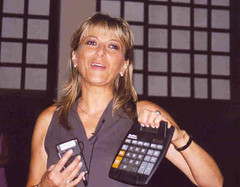
Numbers are our friends. That’s the mantra that Sandra Crucianelli is spreading with the Knight Center course, “Math for Journalists.” The course, which will run from September 12-October 16, 2011, is being offered in Spanish for the Knight Center for Journalism in the Americas. Information about the course can be found here and applicants have until 5 p.m. (CDT), September 2.
“In this course we are going to learn how to treat numbers, not as enemies of journalists but as allies,” said the Argentinian journalist who wants to help journalists get over their fear of math. “Our lives are surrounded by numbers, quantities, crowd estimates, dollar amounts,” she said. “Numbers talk; they tell us things.”
And it’s what they say that can help journalists wade through the mountains of data that comes across their desks—data from governmental and non-governmental sources that arrives “with the calculations already made,” said Crucianelli. She warns that statistical samples can contain errors and that sources may use “a method that wasn’t right” that leads to false conclusions. She hopes that after taking the course, reporters will be able to spot these errors and manipulations.

Using math exercises, Crucianelli will teach students how to estimate crowds, determine the area of an oil spill and even calculate the amount of paint needed to paint the White House. This last exercise once led to a scoop for an intrepid Latin American journalist who uncovered corruption by a mayor who decided to paint his office.
“It occurred to a journalist to check the estimate,” she said recounting the e-mail he sent her, two years after she had taught the course. “It caught his attention because he thought the estimate was too high.” Using the same calculations he had learned with the White House exercise, he discovered the mayor was buying paint for his office and his house. “In reality they bought the paint. They bought ten times more than they needed,” she said. “But they were taking it home, the paint that they didn’t use in the office was being divided among government officials. A form of robbery.”
While the exercises are an important part of the course, Crucianelli also plans to teach basic mathematical operations, volume measurements, percents, indexes, ratios, how to find the mean, median and mode, and how to interpret the consumer price index.
Crucianelli, who specializes in investigative journalism, established her friendship with numbers when she studied the sciences. “During the dictatorship era, there wasn’t journalism,” she explained. “It was dangerous to study the humanities.” Instead, she decided to study bio-chemistry so that she could become a science reporter. “I studied a lot of statistics, chemistry, math, analysis,” she said.
Now she hosts a television news program in her hometown of Bahia Blanca and is the founder and editor-in-chief of SoloLocal.Info, a digital journalism site. She has also won awards from the Inter-American Press Association, the Reuters Foundation and the Biennial Prize from the Argentine Medical Association.
“Math for Journalists” is open to interested reporters from Latin America and the Caribbean. They will have until 5 p.m. (CDT) September 2 to register for the course. There will be a $50 fee to cover administrative cost.
The Knight Center was founded in 2002 with a grant from the John S. and James L. Knight Foundation by Professor Rosental Alves with the goal of helping journalists in Latin America and the Caribbean improve the quality of journalism in their countries. The center also receives contributions from other donors such as the Open Society Foundations and the University of Texas.

Knight Center for Journalism in the Americas
300 West Dean Keeton
Room 3.212
Austin, TX, 78712
Phone: 512-471-1391
Email: journalismcourses@austin.utexas.edu